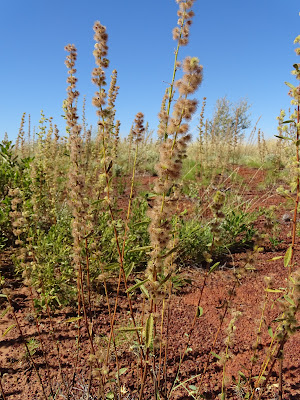Day Two: Thursday, 6th May 2021
Day Two: Thursday, 6th May 2021
The group departed Fitzroy Crossing at 8:24 am, with a long day of driving ahead. After a brief pause to collect the day's lunch from the Ngiyali Roadhouse, during which I took my first flower photo, and also my first bird photo, we continued on the Great Northern Highway in a south-easterly direction.
This is a small passerine bird (feet adapted to perch) which breeds in an area from the Indonesian Andamon Islands to Northern Australia. The term "woodswallow" is something of a misnomer, because it isn't closely related to true swallows, but belongs to the family Artamidae, which includes Butcherbirds, Currawongs, and the Australian Magpie.
At about 10:25 am, we paused at Ngumban Cliff Lookout Rest Area to take in the expansive views, to the north-east, of the Meuller Ranges. Note the open Savanna woodland, and the spinifex in the foreground of the photo below.
Meuller Ranges from Ngumban Cliffs Lookout
At this stop was a variety of wildflowers all located within quite a small area. It was exciting to see the profusion and health of flora.
Purple Mulla Mulla (Ptilotus exaltatus)
Cockroach Bush (Senna notabilis)
Pindan Wattle (Acacia tumida)
Native Cotton (Gossypium australe)
Holly Grevillea (Grevillea wickhamii) also known as Wickham's Grevillea
No common name (Solanum carduiforme) - quite rare
Leaving the Lookout, the road continued easterly, then curved nor-easterly. The landscape continued in a similar form as yesterday, as we passed "Louisa Downs Station", the Lubbock Range, and the Ramsay range - all to the north (left of the bus).
We arived at Halls Creek at about 1:00 pm, and stopped at the Information Centre for the amenities, and a picnic lunch in the park outside. A statue in the grounds commemorates "Russian Jack" (Ivan Fredericks), a famous figure in the 1885 Gold Rush at Halls Creek. The plaque records that he once carried a sick friend over 300 kilometres, in a bush-made wheelbarrow, to seek medical aid, over a track that existed in name only.
"Russian Jack"
China Wall, and Ord River
There were more wildflowers in the area displaying a wide variety of colour, shape, size, and foliage. Quite amazing! And a beautiful little skink.
Pea - no common name (Cajanus cinereus)
No Common name (Hibiscus solanifolius)
Cattle Bush (Trichodesma zeylanicum) also known as Camel Bush, and Water Bush
A juvenile Ring-tailed dragon (Ctenophorus slateri)
The Ring-tailed dragon or Ring-tailed bicycle-dragon is a native species of lizard that may be found in rocky ranges and outcrops of Australia. It was formerly known by the scientific name: Ctenophorus caudicinctus macropus.
Flying Doctor Memorial, Old Halls Creek
Rusted car bodies, Old Halls Creek
The Lodge, Old Halls Creek
Returning to the Great Northern Highway, we now headed northwards until we turned off onto a rough track that led in an easterly direction to our campsite in the Purnululu National Park - APT Picaninny Wilderness Lodge - where we would stay for two nights. As we approached, the Bungle Bungle Range was lit by the setting sun.
Glamping in Purnululu NP
Very comfortable accommodation on quite a cool night
Because of staff shortages, we drove to another campsite - APT Bungle Bungle Wilderness Lodge - for dinner, that was shared with another tour group. Dinner was excellent! We returned to our own camp, and retired for the evening after a day well-spent.
Go to Day Three






























Comments
Post a Comment